Occasionally I will be asked for my thoughts as to whether hitting (bodychecking) should be allowed in women’s hockey. For those unfamiliar with the rules for the women’s game, while body contact is allowed and happens quite regularly, bodychecking is not. Delivering a bodycheck constitutes a two-minute minor penalty.
If you really want to know my personal opinion, I have never thought that hitting was necessary in the women’s game. I feel that incorporating bodychecking would take away from what I enjoy most about women’s hockey – the skating, the playmaking, the puck battles, the sheer grace of the game.
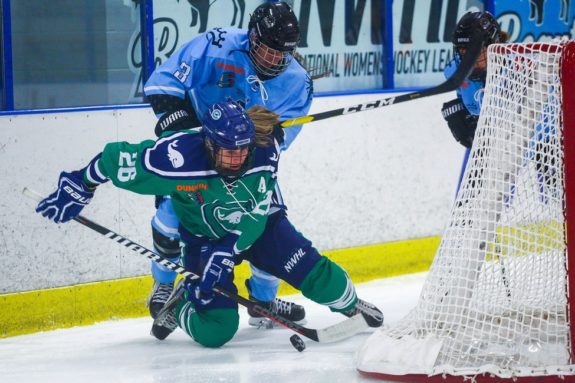
Without being able to bodycheck in order to neutralize an opponent or create a turnover, there is a much more cerebral, tactical approach to women’s hockey that you do not find in other sports. It is what led me to following the game since Nagano ’98 and find a hockey hero in one of the players whose opinions I will be offering up shortly.
My own opinion carries only a (very) modest weight to it, though I certainly appreciate any instance where I am asked to comment on the game that I love dearly. So when it was posed to me – “should there be hitting in women’s hockey?” – the first thought that came through my head is that I am the wrong person to answer this question.
The players have always been far better suited to respond to questions such as these, and they are the ones whose opinions matter the most in this regard. Therefore, having posed the question to them instead, I have gathered the thoughts of 19 different current and former players from around the world to weigh in on the matter.
Included among the 19 are eight Olympians, two Angela James Bowl winners, three Isobel Cup champions, five Clarkson Cup winners, two NCAA champions and two current NCAA Division I players. I am very thankful for all of the opinions that each of them shared with me.
Pernilla Winberg – Linköping HC forward (SDHL); 4-time Olympian for Sweden
“I think it would be hard to change the rules right now, and it would probably take some time for players to adjust. I like it how it is right now because it’s still physical but also very skilled hockey since it’s not all about hitting.”
A. J. Mleczko – 2-time Olympian for Team USA; NBC and MSG Networks hockey analyst
“I do not think the game needs it. As one of the bigger players when I played, I imagine it would have benefited me, but the game is physical, fast and incredibly entertaining as it is currently played. The only argument for checking would be to make a more consistently reffed game – it would help minimize the gray area that is at the ref’s discretion. But as the game continues to evolve, the officiating has become more consistent. I don’t think adding checking would be terrible, but I just don’t think our game needs it.”

Alyssa Gagliardi – PWHPA defender; Isobel Cup and Clarkson Cup champion
“I think the women’s game thrives with body contact as it currently is because it better highlights the skill of the game – passing, skating, shooting, stick handling, making plays. You even see the boys and men’s game transition to more of a focus on body contact and less of the hardcore open ice hits because at the end of the day, the point of the game – men’s or women’s – is puck possession and scoring goals. I think the talent and skill of the women’s game is best showcased in its current form.”
Jillian Dempsey – Boston Pride team captain; Isobel Cup and Clarkson Cup champion
“The women’s game is a great balance between skill and physicality. Even though there isn’t hitting, there’s plenty of body contact and battling. I like the focus being on speed and skill.”
Tatiana Shatalova – Metropolitan Riveters forward; former member of Russian Women’s U18 National Team
“I think that just like in men’s hockey that women’s hockey has emotions too. Sometimes you want to use your hands and your body. On the ice, we don’t have to be ‘feminine’ – this is hockey.”
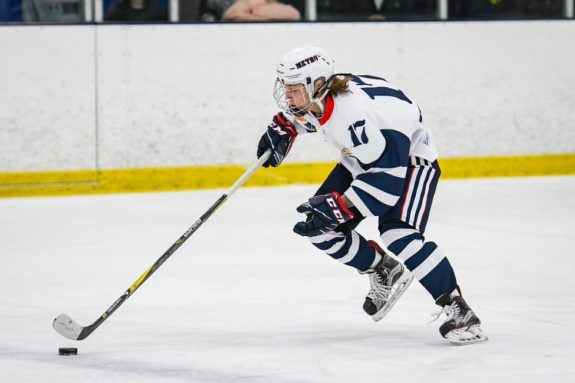
Caroline Ouellette – 4-time Olympic gold medalist for Team Canada; a Clarkson Cup and NCAA champion
“I like our game the way it currently is with bodychecking disallowed. However, I would like to see allowed body contact along the boards when two players are skating in the same direction. I believe that referees should only call blatant bodychecking and let a lot of physical play go. Our game should mostly be played 5-on-5. Unfortunately, right now, we have to adjust to each referee from game to game as some are very lenient with physical contact and some are very severe. I want the physical play to be allowed.”
Marie-Jo Pelletier – Buffalo Beauts All-Star defender
“I don’t believe hitting would be beneficial to women’s hockey as it could take away from some of the skill that is being showcased. The women’s game can get pretty physical without there being hitting. It could also discourage some young girls to continue playing the sport.”
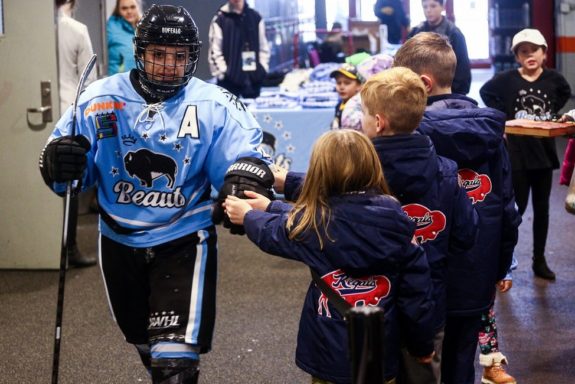
Venla Hovi – 3-time Olympian for Team Finland; Clarkson Cup champion
“I think hitting in the women’s game is unnecessary. The game is getting faster and faster, and the number of head injuries – in both women’s and men’s hockey – is alarming. Women’s hockey is a physical game based on skill and tactics, and I think men’s hockey will eventually have to adjust and make changes.”
Jonna Curtis – Minnesota Whitecaps All-Star forward; Isobel Cup champion
“I may be biased but I think what makes women’s hockey stand out is the finesse we bring because we can’t hit. And just because we can’t ‘bodycheck’ doesn’t mean our games aren’t physical. Any women’s hockey fan can tell you that our games are very physical. I love a physical game, but it’s just a different style that we have adopted. So I guess I would say I don’t think ‘bodychecking’ is needed in women’s hockey.”
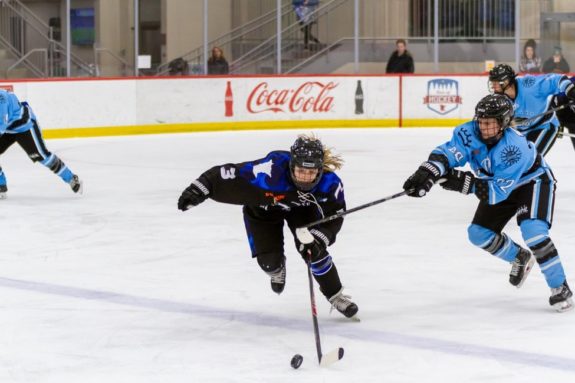
Alexandra Vafina – SK Gorny Ukhta forward in ЖХЛ; 2-time Olympian for Team Russia
“Personally, I think bodychecks and hitting in women’s hockey aren’t necessary. It’s the game itself that is interesting. The beauty and the aesthetics of ice hockey are concentrated in our style of the game without rough and tough play. People like to watch the tactical style of the game, on-ice interactions between linemates, and beautiful stickhandling movements.”
So Jung Shin – Olympian with 2018 Korean Women’s National Team, former Metropolitan Riveters goalie
“I think women’s hockey players in top leagues are already hitting during the game, but not full-on bodychecking. The hitting is part of women’s hockey now, and probably audiences expect to watch hitting in women’s hockey (when they tune in). Female hockey players play at a very high level for performing anything on the ice.”
Eveliina Suonpää – Linköping HC goalie; 2-time Olympian for Team Finland
“From my perspective, it is kind of hard to say since it doesn’t affect my game as much. The women’s game is already very physical, but right now it’s really hard for the refs to differentiate what ‘contact’ means. Maybe there could be room for changes in the rules to allow more body contact without it overtaking the game.”
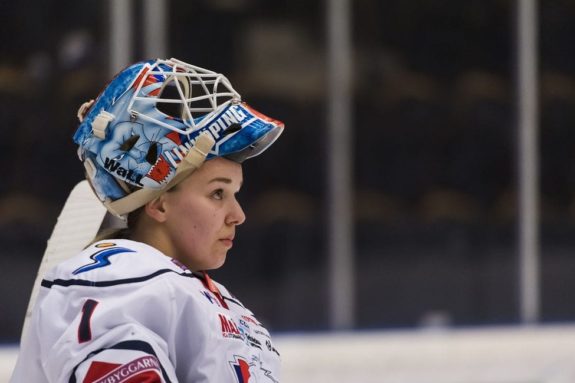
Jenny Harß – 2-time Olympian for Team Germany; NCAA champion with UMD
“I guess I could go either way with it. I don’t think bodychecking would define women’s hockey since it can be quite physical already anyways.”
Alva Johnsson – Long Island University forward; former member of Swedish Women’s U18 National Team
“I love the physical aspect of the game. I am a big, smart player who plays very physical, so bodychecking would really benefit me and my game. I do like the way our game has developed without bodychecking – the fast, smart and technical game. But personally I think women’s and men’s hockey should have the same rules to make the sport grow and get more people to watch.”
Hanna Thuvik – Swedish Women’s U18 National Team
“I think we should change the rules and allow bodychecking and body contact in women’s hockey. Today, the biggest difference between women’s and men’s hockey is the body contact and pace. Many people probably think that the beauty of the game would be ruined and others are worried that the flow would deteriorate. But I don’t think bodychecking would ruin the women’s game. Rather, I think the pace would increase as the girls became stronger and wiser. That would include being able to receive, give and undercut the bodychecking.

The risk is that the concussions would increase, but I think if girls got to learn the body contact at the same age as guys, then more and more players would be prepared to receive bangs like this. If the girls were given a chance to do bodychecking, then I think interest in women’s hockey would increase. People miss the physical game. With bodychecking included, I think we can open the women’s game up to a larger audience.”
Noemi Neubauerová – Colgate University forward; member of Czech Republic Women’s National Team
“Personally, growing up playing boys hockey I was used to playing the body for the most part. I still find myself being more physical in some moments during a game. In my opinion I think playing the body is an important aspect of hockey, and since it is females playing against females, I would say to some extent bodychecking should be allowed.”
Jess Jones – PWHPA forward; 2016-17 CWHL Angela James Bowl recipient
“Personally I don’t think there needs to be hitting in the women’s game. I think if you see the way the men’s game is going now it’s kind of shying away from hitting a bit more and going towards more skill and speed. I think that’s what the women’s game is about today. The body contact is great. I think we can even allow a little more of it but the game is moving away from those big open ice hits. It’s all about positioning and angling which is very challenging. “
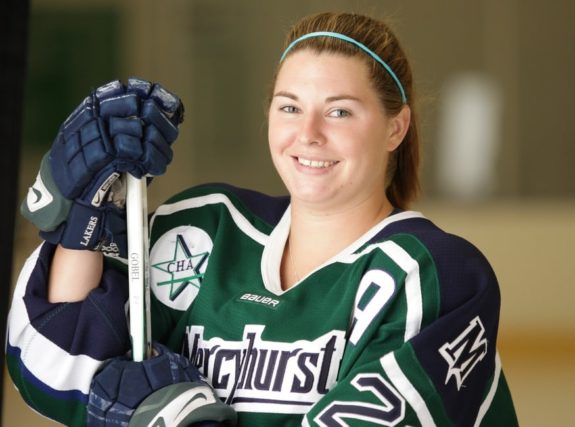
Emma Vlasic – Connecticut Whale All-Star forward
“I think there already is a lot of bodychecking in the women’s game, in my opinion. I think the speed of the game is the most important aspect of both the men’s and women’s game, and it’s not as much the hitting that takes away from the speed but the hooking.”
Kateřina Mrázová – Brynäs IF forward; Clarkson Cup champion and member of Czech Republic Women’s National Team
“I think bodychecking is a part of hockey and it should be allowed in women’s hockey as well. I am talking about bodychecking from the side when it is shoulder on shoulder, same level. Also, not allowing bodychecking causes so many other penalties like slashing or tripping and it is harder to take the puck from an another player.”
it would sure reduce the amount of unnecessary and ridiculous penalties being called constantly. Maybe I wouldn’t have had to spend so much time in the penalty box for being good at hockey…
I’ll go against all my training, playing and coaching years to point out the obvious. Why not bring bodychecking back to women’s hockey? I’ll bring out the elephant in the room. Concussions. Brain injury. Long-lasting, life altering ramifications. Anyone on the side of increasing contact in any sport, regardless of gender, is not getting the message. I played tough. I was concussed. In total from Jr. hockey to semi-pro in Europe upwards of 35-40 times. Not unconscience. Seeing stars, headaches, dizziness. All the things I(we) were taught to ‘shake off’. Now at 49 years of age I am suffering the repercussions. It is not about toughness. It is not about financial restitution. Millions in salaries can not buy a functioning brain. Making top dollar salaries is amazing. No doubt. It also clouds the judgement of parents, agents, the players(young) who all have dollar signs in their eyes. All the money in the world will not buy you back your mental health. Your quality of life. All the money in the world is nothing when you have lost the will, the capacity, to enjoy it. In a world where we are finally coming to grips with our athletes mortality and the vulnerability of their most important organ; Why? Why would we think to actually ‘add’ more collision and contact to a sport without it? Why?
This reminds me of Ken Campbell’s article at The Hockey News on the Toronto minor league that was thinking of banning checking because these players simply weren’t going to need it in the future. I didn’t disagree with the thought process, as much as I like checking. (http://www.thehockeynews.com/blog/toronto-minor-hockey-league-aims-to-further-curb-bodychecking/)
While checking can certainly liven up a game and make it more enjoyable, there is a big stumbling block to introducing checking in the professional women’s league: these women aren’t making money from this sport.
They have day jobs, and don’t have the ability to relatively easily take months off of work for a concussion like an NHL player does. They don’t make millions (or a million) per season and are playing because they love it, not because they love it and happen to be showered with money and attention for it. For them, an injury can be much more serious problem, and until they actually make a living wage, can’t be asked to sacrifice their safety and health for the game.
But you’re entirely right that the no-checking rule for women and girls is based on sexism.
Great article Callum. When your old teammate started playing hockey (years ago), I remember KMHA doing a poll about checking. There was much great debate in our house on the subject matter. I was not the biggest proponent of hitting in hockey – boys or girls! As the years moved forward and as the competition grew, I came to enjoy hitting. I will now put it a caveat, of “good clean” hitting! As a nurse, trainer, and concussion specialist, you would think I should hate it but I don’t! Quite frankly, I couldn’t imagine a game without Derek’s hard hits! He was so good at it! So that’s my view on hitting… As for women vs men… Well I could never figure out why women were not allowed to hit. I however can say that I would probably watch it more if there was good clean hitting. If you don’t want to hit, play ringette. It’s a wonderful sport! I played both and quite prefer ringette to be honest (sorry ladies)! As women, it’s the one break we do get!! To your point Callum, women would not necessarily have more injuries. I do however think that EVERY player at all ages, boy or girl, be taught HOW to check safely – from day one! Removing checking in minor hockey as they have done was a narrow focused and bandaid solution to concussion injuries. I think we will see more and more severe injuries when kids move over because of lack of skill development. While checking may contribute to concussions, over my 10 years span at both competitive and rec levels, I would venture to say I saw more shoulder separations as a results of a hit. So I say, train up our players, boys and girls alike! Let them hit -good, clean and hard! And if the refs do their job properly, and nip problem players in the bud, this game we all love so dearly will be enjoyed as it should be for many years to come!